You interact with conversational artificial intelligence (AI) every day, whether you’re asking Alexa for the weather, using a customer service chatbot, or drafting an email with ChatGPT.
But what’s the real difference between all these terms? Is conversational AI the same as generative AI? Is ChatGPT a chatbot? The technology is moving so fast that the terms are getting confusing.
In this guide, we’ll clear up the confusion. We’ll break down what conversational AI is, how it differs from generative AI, and show you examples of how this technology is shaping next-generation business processes and customer experiences.
What Is Conversational AI?
Conversational AI is a set of technologies that allows computers to understand, process, and respond to human language (both voice and text) in a natural, human-like way. It enables a real, back-and-forth conversation, moving far beyond simple, one-word commands.
To work, conversational AI combines several key technologies:
- Natural language processing (NLP): The ears that hear or read the human language.
- Natural language understanding (NLU): The brain that figures out the intent and context of what was said.
- Natural language generation (NLG): The voice that forms a human-sounding, grammatically correct response.
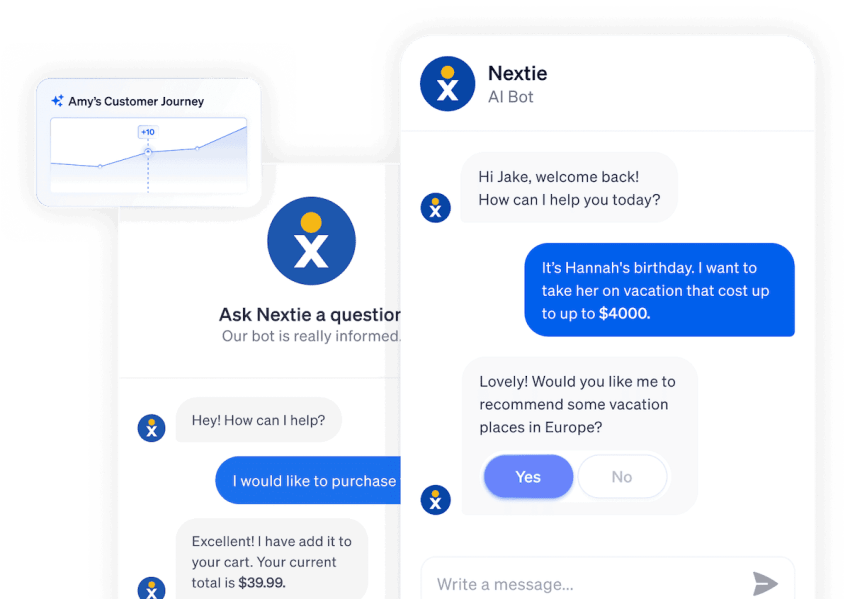
ChatGPT is a great example of conversational AI. It’s a generative AI-powered chatbot built on a large language model (LLM).
- Its conversational AI part allows it to understand your questions, remember the context of your chat, and respond in a natural, human-like way.
- Its generative AI part allows it to create new, original content (like writing a poem or debugging code) instead of just pulling from a pre-written script.
This combination makes newer conversational AI systems far more capable than older, rule-based bots that struggled with real human conversation.
Conversational AI vs. Generative AI vs. Chatbots: What’s the Difference?
This is the biggest point of confusion for most people. Here’s a simple breakdown of how each technology differs and which one is right for you.
| Technology | What it does | Breakdown | Example |
|---|---|---|---|
| Basic chatbot | Follows a pre-programmed script (a decision tree). | A vending machine. You press “B4,” you get “B4.” | An old airline bot that only understands “Check flight status” or “Book flight.” |
| Conversational AI | Understands intent and context. | A skilled human translator. It doesn’t just translate words; it translates meaning. | An AI-powered IVR that lets you say, “My flight was canceled and I need to rebook for tomorrow morning.” |
| Generative AI | Creates new, original content. | An author or an artist. You give it a prompt, and it writes a new story. | Using ChatGPT to “Write an email to my boss asking for Friday off.” |
How they work together: AI tools (like an AI Copilot or ChatGPT) combine all three. They use conversational AI to understand your request and generative AI to create a unique, relevant answer, all delivered through a chatbot interface.
Benefits of Conversational AI for Your Business
Here are some benefits conversational AI brings to your business:
Provide 24/7, instant customer answers
Conversational AI handles routine questions around the clock. Customers can check their order status, reset a password, or get account details instantly, without waiting in a queue. This responsiveness is critical, as 90% of consumers consider an immediate response to be important or very important, and 51% of consumers actually prefer interacting with a bot for immediate service.
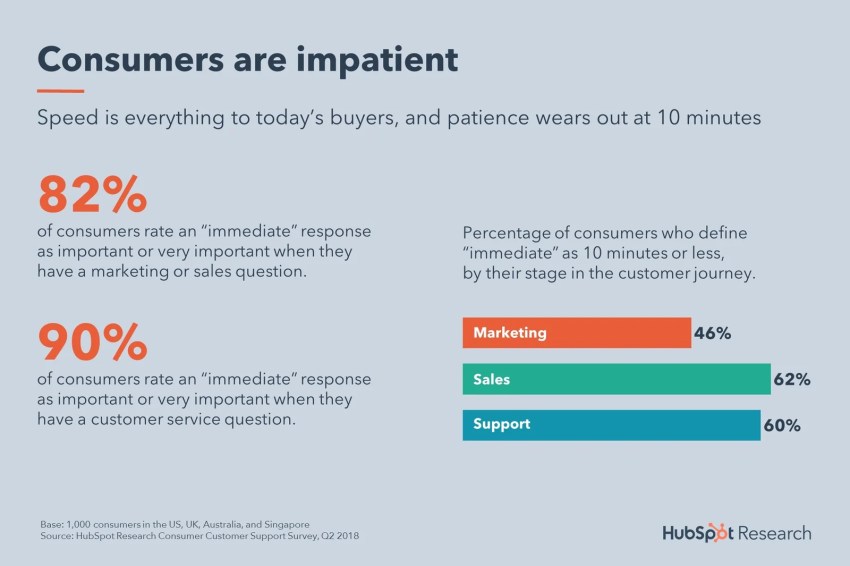
Turn your agents into super agents
AI enhances, not replaces, your support team. Tools like AI copilots listen to live calls and deliver instant information, from customer details to product data. A study by the National Bureau of Economic Research (NBER) found that support agents using a generative AI assistant boosted their productivity by 14% on average, especially helping beginners and low-skilled workers. After the call, a conversational AI system can automatically create AI summaries and update records, allowing agents to focus on service rather than paperwork.
Identify customers needs
AI reviews every customer interaction — calls, chats, and emails — to detect trends and recurring issues. This data helps you understand customer sentiment, upgrade products, and address problems before they grow. This is why 70% of CX leaders believe chatbots are becoming skilled architects of highly personalized customer journeys, according to Zendesk.

Deliver hyperpersonalization
When connected to your CRM, conversational AI recalls each customer’s history and preferences. This is vital, as 72% of B2B customers now expect a deep understanding of their needs, reflected through personalized experiences. Whether the customer starts on chat, email, or phone, the system ensures context stays intact, eliminating the need to repeat details.
How Conversational AI Works
Conversational AI uses a sophisticated, multi-stage process to understand and respond to human language.
- Input collection: The user provides input by either speaking or typing. If the input is voice, an automatic speech recognition (ASR) component first transcribes speech into text.
- Intent recognition (NLU): The natural language understanding engine analyzes the text to determine the user’s intent. It doesn’t just see words; it identifies what the user is trying to achieve (e.g., book a flight, check balance, reset password).
- Context and dialogue management: The AI analyzes the user’s intent within the context of the conversation. It accesses its memory (similar to large language models or LLMs) and external databases (such as your CRM) to understand who the user is, their history, and what was said previously.
- Response generation (NLG): Once the AI has decided what to say, the natural language generation component determines how to express it. It creates a grammatically correct, natural-sounding, and contextually appropriate response in human language.
- Delivery: The system delivers the response. If it’s a chatbot, the text is displayed. With a voice assistant, a text-to-speech (TTS) engine converts the text back into human-like speech that the user can hear.
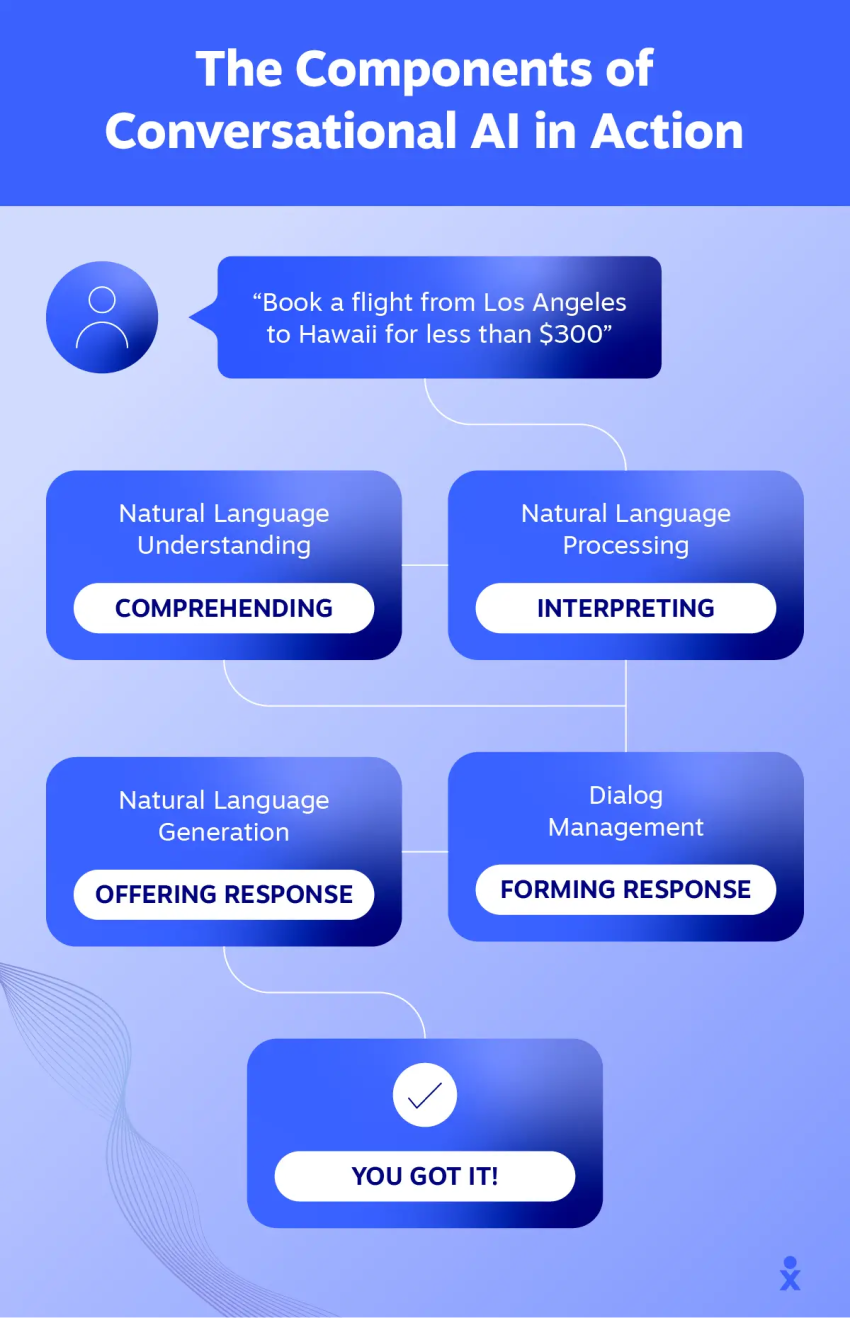
Real-World Use Cases and Industry Applications
Conversational AI appears in various forms in voice, chat, and interactive systems.
- Virtual assistants and smart speakers: Devices such as Amazon Alexa, Apple Siri, and Google Assistant use conversational AI to process voice commands. They can answer questions, play music, set reminders, and control smart home devices.
- Customer support chatbots: Many websites feature AI chatbots that handle customer queries in real time. They answer common questions, track orders, or transfer complex issues to human agents, reducing wait times and lowering operational costs.
- AI copilots and agent builders: AI copilots, such as Nextiva’s AI Copilot, assist support teams by offering real-time suggestions during calls. Agent builders, such as Google Dialogflow, are platforms that allow businesses to create their own custom AI assistants for specific use cases.
- Interactive voice response (IVR): Business phone systems use conversational AI to replace “press 1 for support” menus. They allow callers to describe their issue naturally, and the system routes them to the right department or provides an instant answer.
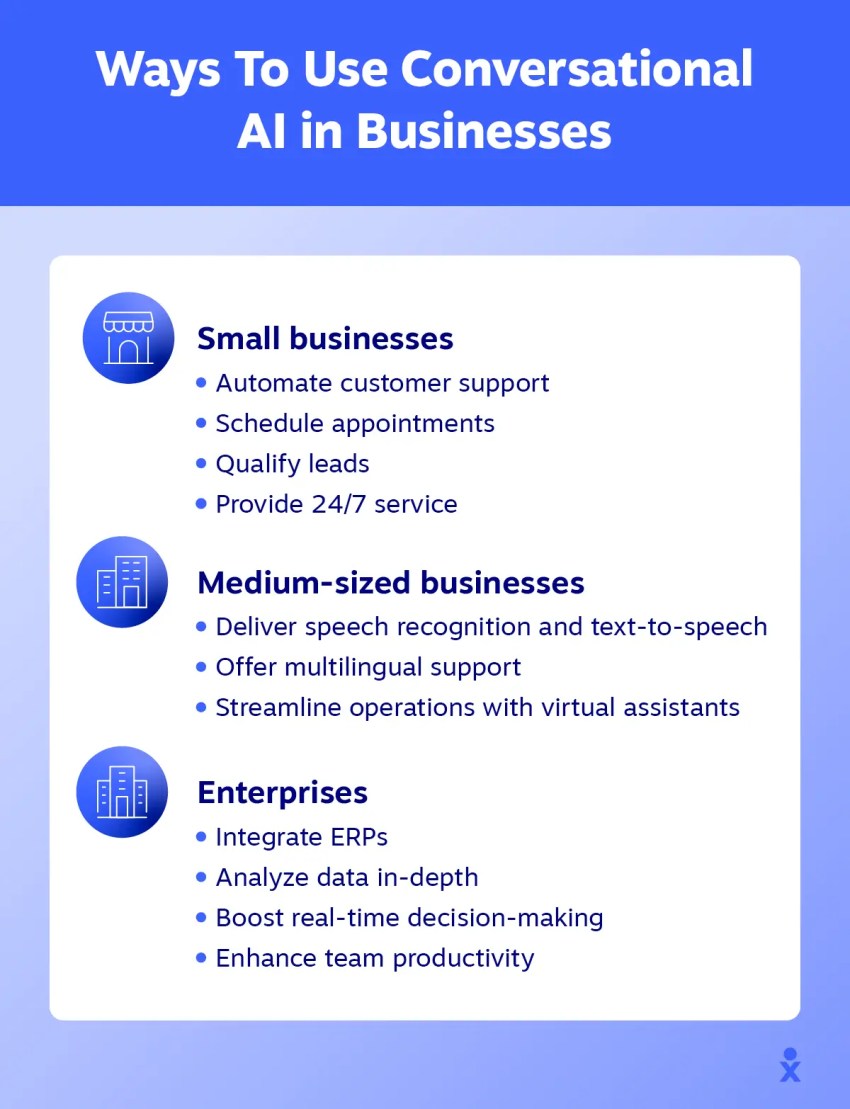
Industry-specific applications
Conversational AI is being heavily adopted across major industries.
- Finance: The banking (BFSI) industry is a major conversational AI adopter, with a 23% market share in 2024. Common uses include real-time fraud alerts, account balance inquiries, and automated payment processing.
- Healthcare: The adoption of chatbot technology in healthcare is expected to grow by 33.72% between 2024 and 2028. It’s used for patient onboarding, symptom checking, and scheduling appointments.

Future Trends and Innovations in Conversational AI
Conversational AI technology is evolving quickly, moving from simple Q&A to fully autonomous assistants. Key trends include:
- Emotional AI and sentiment analysis: Future AI will understand not only what you say, but also how you say it. It can recognize customer sentiment, tone of voice and word choice, recognize frustration, joy, or urgency, and adjust its response accordingly.
- Proactive interaction: Instead of simply reacting to customers, AI will actively initiate helpful conversations. For example, AI can notice you’re having trouble on a checkout page and proactively ask, “You seem to be having some issues. Can I help you redeem the discount code?”
- Multimodal AI: Conversations are no longer limited to text or speech. New models can seamlessly process various inputs. For example, a user could point their camera at a product, circle a part of it, and ask, “How do I fix this part?”
- Autonomous agents: The next step is the evolution from conversational AI to agentic AI. This is an AI that can be given a complex, multi-stage goal (e.g., “Find and book a flight to Miami for next Tuesday, get me a beachfront hotel for under $200, and add everything to my calendar”), and it will perform all the necessary actions independently.

How To Successfully Implement Conversational AI in Your Business
To optimally use conversational AI, follow this simple framework that covers the entire process from planning to optimization.
1) Choose your strategy and tool category
First, decide how you want to build. Your choice depends on your business goals, budget, and technical resources.
- Foundational platforms (the do-it-yourself approach): These are powerful toolkits from companies like Google Cloud (Dialogflow) or Microsoft (Azure AI). They’re aimed at large companies with development teams that need to build a highly customized AI agent from scratch — for example, an airline integrating AI into multiple existing booking systems.
- Standalone chatbots: These are simple point solutions. A marketing team might use such a chatbot on a landing page to ask a few qualifying questions. However, they often lack comprehensive integration with other business tools.
- Integrated business platforms (the ready-to-use approach): This is the most effective approach for most companies. Companies like Nextiva integrate powerful AI directly into the tools you already use, such as your phone system, contact center, and CRM. This allows you to start small and scale — all on a single platform.
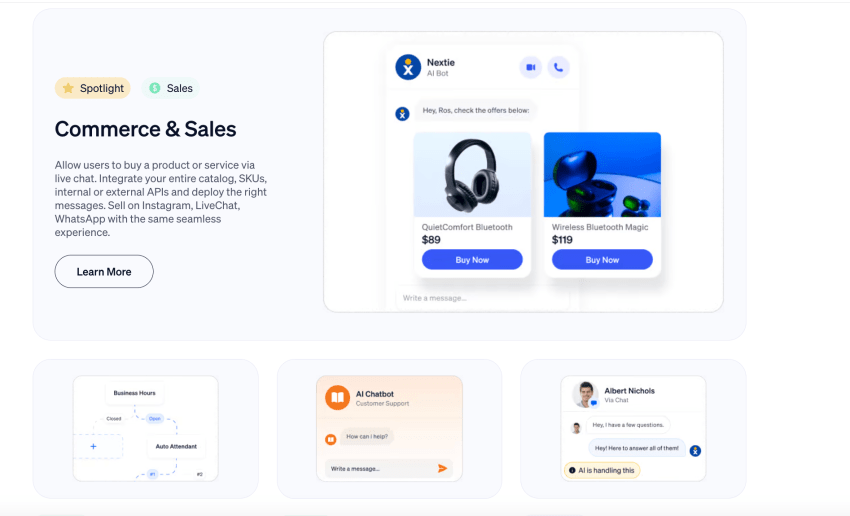
2) Start with a single, high-impact problem
Don’t try to automate everything at once. Define a clear business goal by finding one repetitive, high-volume task that’s draining your team’s time. Good starting points include:
- Answering order status inquiries or password resets.
- Qualifying inbound leads on your website.
- Automating post-call summaries for your agents.
This gives you a measurable objective to prove your return on investment (ROI).

👉 Ready to measure the impact? Try the ROI Calculator
3) Design the human handoff first
The most critical step is planning the escape hatch. Customers get frustrated when they are trapped in a bot loop. Always provide a clear, one-click option to talk to an agent. A successful AI workflow is one that seamlessly transfers the customer, along with the full conversation history and context, to the right human agent without forcing them to repeat their queries.
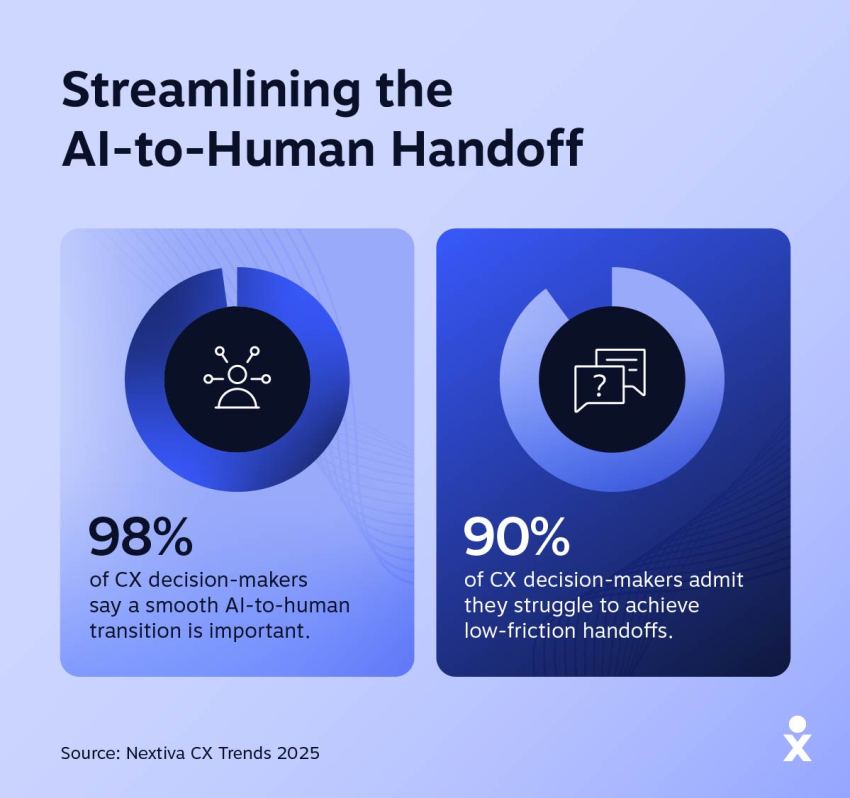
4) Train, test, and optimize
Your AI is only as smart as the data it’s trained on. Train your AI on your company’s high-quality data, including your help articles, product specs, and past customer conversations. Once live, use conversation analytics to see where the AI is failing or where customers are getting confused, and use that data to optimize its conversation flows.
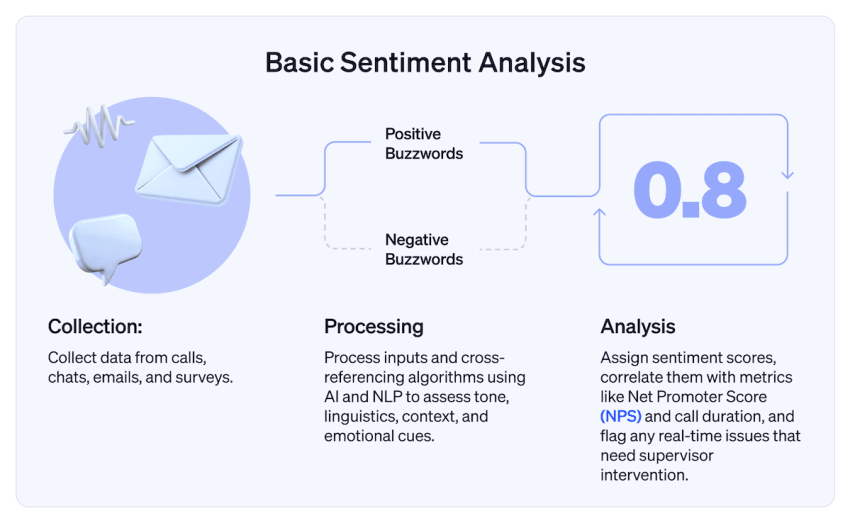
Build Intelligent Customer Conversations With Nextiva
To start reaping the rewards, select the right platform to kickstart your conversational AI journey. Numerous custom options, such as AI-powered conversational chat windows and embedded interfaces, are available for your website or tailored integration. Plus, software like Nextiva keeps you available around the clock, supporting customers whenever they need it.
Scale up with contact center AI.
The modern contact center has arrived. See how Nextiva helps you deliver the best customer experience at scale.
Conversational AI FAQs
An AI chatbot is typically customer-facing. It’s designed to automate interactions and answer customer questions independently (e.g., on your website). An AI copilot (like Nextiva’s) is employee-facing. It acts as a real-time assistant for your agents, listening to calls and providing instant suggestions, customer data, and automated summaries to help the human perform their job better.
The two biggest challenges are data quality and the human handoff. The AI is only as smart as the data it’s trained on (your help articles, product specs, etc.). More importantly, you must design a seamless, one-click escape hatch for a customer to reach a human agent. Without a good handoff, customers feel trapped and frustrated, which defeats the purpose.
Yes. Many of the most popular tools have free tiers, including ChatGPT, Google Gemini, and Microsoft Copilot. For businesses, many chatbot tools also offer free plans for a limited number of conversations.
The concept began with the “Turing Test” in 1950. The first chatbot, ELIZA, was created in 1966 and simply matched patterns. It evolved slowly until the 2010s with the launch of Siri, Alexa, and Google Assistant. The modern era began with the release of LLMs like those powering ChatGPT, which made AI accessible to everyone.
Yes, and this is one of its most critical functions. The real power of conversational AI is unlocked when it’s integrated with your CRM, helpdesk, and other systems. This allows the AI to access customer history for personalization (e.g., greeting customers by name) and automatically save conversation summaries and update customer records, saving your team valuable time.

















 Business Communication
Business Communication 









